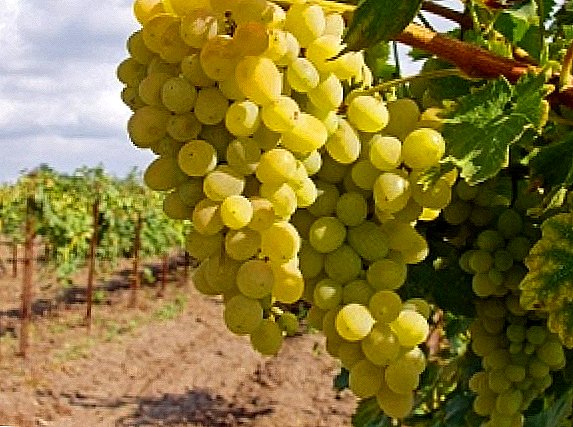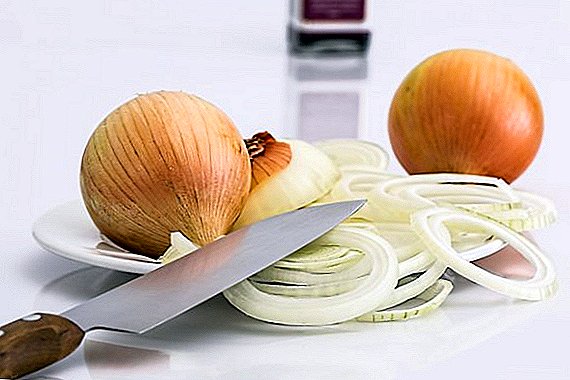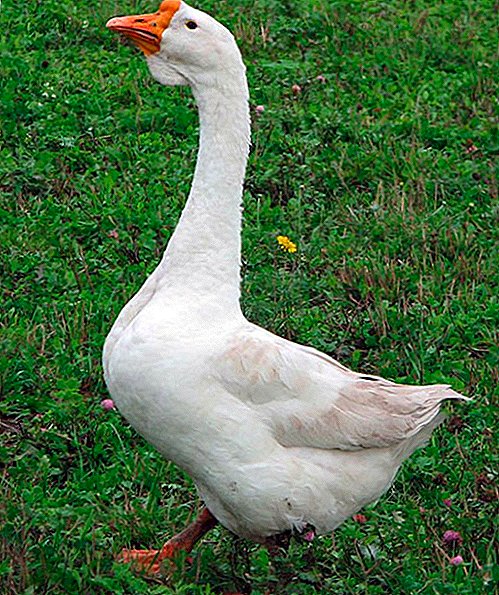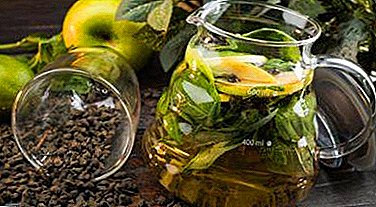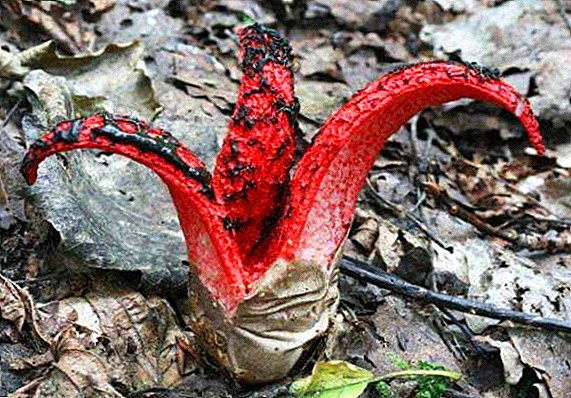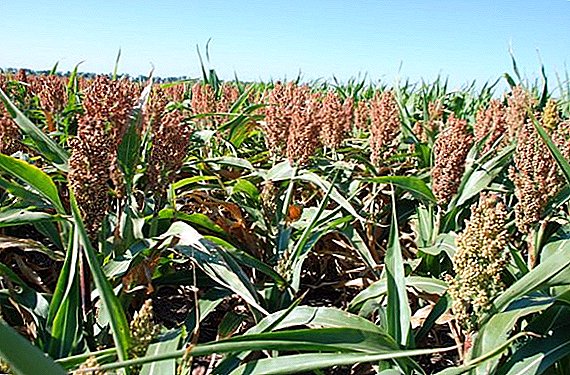 About sorghum today, few people know. However, this plant has a large number of useful properties and has a huge potential for active use in various sectors of industry, forage. In this article you will learn what sorghum is, its most popular types and areas of application.
About sorghum today, few people know. However, this plant has a large number of useful properties and has a huge potential for active use in various sectors of industry, forage. In this article you will learn what sorghum is, its most popular types and areas of application.
What is sorghum
Sorghum is an annual or perennial grass plant. Refers to spring crops. His homeland are areas of East Africa, where the plant began to grow in the IV century BC. er Culture on the scale of world production is in fifth place. Such a high popularity of sorghum due to the fact that the plant is unpretentious in the care, gives a great harvest and has many useful properties that can be used in different industries. Very beneficial is that the cultivation of culture does not require special equipment and machinery.  Sorghum is a very thermophilic plant. For its normal development and yield is necessary during the growth of the prevalence of a temperature of 25-30 ° C. Frosts can lead to the death of the crop. At the same time, sorghum is very resistant to droughts, various kinds of pests and diseases. It has a well-developed root system. Undemanding to the composition of the soil, it grows on both loamy and sandy, clayey rocks. It needs regular treatment from weeds, and in the conditions of development on poor land, it is also in additional fertilizer. The plant is very rich in nutrients, vitamin complex.
Sorghum is a very thermophilic plant. For its normal development and yield is necessary during the growth of the prevalence of a temperature of 25-30 ° C. Frosts can lead to the death of the crop. At the same time, sorghum is very resistant to droughts, various kinds of pests and diseases. It has a well-developed root system. Undemanding to the composition of the soil, it grows on both loamy and sandy, clayey rocks. It needs regular treatment from weeds, and in the conditions of development on poor land, it is also in additional fertilizer. The plant is very rich in nutrients, vitamin complex.
Important! Sorghum is a valuable source of protein and carbohydrates. Therefore, grain grade cereals can be effectively used as an additive to the diet in the field of sports nutrition for building muscle mass and replenishing energy costs.
Common sorghum species
There are many types of sorghum: about 70 cultivated and 24 wild. They differ somewhat in characteristics, composition and scope of application. Sorghum is a real storehouse of vitamins and beneficial elements. However, in cooking it is quite difficult to use, because the croup has a thick, bitter-tasting skin. At the same time, the plant is very actively used in the industrial sector, for feeding livestock. Depending on the scope of use Sorghum is classified into the following species:
- grain;
- sugar;
- lemon;
- marily;
- grassy.
Cereal sorghum
 Grain sorghum is used in the food industry. Since ancient times, this type of plant among the peoples of Africa was considered one of the most important products for cooking. Since sorghum is resistant to the conditions of a dry climate, during periods of drought this plant is practically the only source of nutrients for Africans.
Grain sorghum is used in the food industry. Since ancient times, this type of plant among the peoples of Africa was considered one of the most important products for cooking. Since sorghum is resistant to the conditions of a dry climate, during periods of drought this plant is practically the only source of nutrients for Africans.
Sorghum is widely used for the production of:
- starch;
- flour;
- cereals.
Sorghum starch is used in the food, mining, textile, paper, medical industry. Many plant species exceed even corn by starch capacity. At the same time, the cultivation of a crop and its processing are much easier than the cultivation of corn.
The most fruitful such grain varieties are considered: "Kaoliang"; Durra; "Jugra". In addition, today, a large number of grain variety hybrids have been developed, which in terms of yield and quality characteristics are not inferior to the main species.
 The most productive hybrids are: "Titanium"; "Quartz"; "Emerald"; "Eritrea". Hybrids that are most enriched in starch include:
The most productive hybrids are: "Titanium"; "Quartz"; "Emerald"; "Eritrea". Hybrids that are most enriched in starch include:
Grand; Eritrea; "Titanium". In terms of protein content, the best varieties are: "Titan"; "Quartz"; "Pearl".
Did you know? This species is very popular in animal husbandry and poultry farming as feed. To increase the amount of egg production in the feed for chickens, it is recommended to add up to 40% of sorghum grain instead of corn and wheat.
Sugargrass
In the juice of the stems of this species there are up to 20% sugar. Due to such a high index, sugar sorghum is mainly used for making honey, jam, alcohol, and various sweets. In addition, the plant stems are used in the production of feed, vitamin complexes, food additives.
Sorghum stalks contain large quantities of sucrose. The largest amount of the substance in the plant is concentrated after its flowering. Sugargrass sorghum is very popular in production, because the crop produces a good crop and is not demanding on soil composition, climatic conditions (except for the need for heat), tolerates drought well, and shows high yields even on poor soils. Due to these characteristics, recent interest in this plant has increased in all countries with suitable climatic conditions.
Important! Sorgovy sugar, unlike cane, beet, is dietary. It can be used by people suffering from diabetes.
 The results of the research show that the cost of sugar from sorghum is half the price of the same product made from cane and beets. In addition, much less pesticides are used in the cultivation of this crop, which is explained by the high resistance of the plant to diseases and pests. Thus, the product based on sorghum is much more environmentally friendly and healthier.
The results of the research show that the cost of sugar from sorghum is half the price of the same product made from cane and beets. In addition, much less pesticides are used in the cultivation of this crop, which is explained by the high resistance of the plant to diseases and pests. Thus, the product based on sorghum is much more environmentally friendly and healthier.
Sugar grade sorghum is widely used as animal feed. Silage and hay are produced from it. The products are rich in nutrients. Mixed silage from sorghum and maize is considered the most optimal feed in the livestock sector.
Sorghum of this variety can also be used in the field of bioenergy. It is made of:
- bioethanol;
- biogas;
- solid fuel.
Did you know? In China, sugar grade sorghum is considered the best source of biofuels. For this reason, the cultivation of culture laid in the state plan.
Lemongrass
 Lemongrass has a pronounced lemon flavor. Due to this property, the plant is widely used in perfumery, as well as cooking (as a spice or basis for brewing tea). Sorghum can be used both in dried and fresh form. Dried plants before use should be soaked in water for about two hours. In cooking, use the stem, pulp and onion. The stem is hard, so it is cut into thin strips before being added to the dish. Lemongrass sorghum is very popular in Asian, Caribbean, Thai, Vietnamese cuisines. It is widely used for cooking marinades. As a spice, it is excellent for fish, meat dishes, vegetable soups, salads.
Lemongrass has a pronounced lemon flavor. Due to this property, the plant is widely used in perfumery, as well as cooking (as a spice or basis for brewing tea). Sorghum can be used both in dried and fresh form. Dried plants before use should be soaked in water for about two hours. In cooking, use the stem, pulp and onion. The stem is hard, so it is cut into thin strips before being added to the dish. Lemongrass sorghum is very popular in Asian, Caribbean, Thai, Vietnamese cuisines. It is widely used for cooking marinades. As a spice, it is excellent for fish, meat dishes, vegetable soups, salads.
Very tasty and healthy tea based on this plant. Culture stems are poured with hot boiled water and infused for about ten minutes. It turns out a great tonic flavored drink. Moreover, it is very useful for colds.
This type of sorghum has pronounced antiseptic, antibacterial, antipyretic properties. Due to this, they are widely used in medicine in India, China, and Vietnam for the treatment of infectious diseases, as well as a febrifuge.
Important! Lemongrass is very effective in combating seborrhea. With it, you can also strengthen the hair well, give it shine, and also prevent baldness.
In the perfumery using the essential oil of sorghum. It is also effective against mosquito bites and tsetse flies.
Technical or venice sorghum
 Broom sorghum is profitable to grow on the plot. Birds can be fed with its grain, and straw-washed straws can be used to make brooms. Seeds of such sorghum are inexpensive, plus the whole plant is completely unpretentious in the care, grows even on infertile soils, gives a great harvest. Therefore, with the help of venice sorghum, you can create a good profitable business.
Broom sorghum is profitable to grow on the plot. Birds can be fed with its grain, and straw-washed straws can be used to make brooms. Seeds of such sorghum are inexpensive, plus the whole plant is completely unpretentious in the care, grows even on infertile soils, gives a great harvest. Therefore, with the help of venice sorghum, you can create a good profitable business.
The technical sorghum has many types, the color and shape of panicles for making brooms depends on it. The most valuable species are those that have even, elastic, panicles of equal length with dense branching at the ends. Red panicles are least valued because they are very tough. Technical sorghum is also used for making paper, wicker things.
Grass sorghum
Grass sorghum is widely used for feeding purposes. It has a juicy core and is rich in nutrients. Since sorghum grains have a hard shell, it needs to be kneaded before feeding the livestock. The shell contains tannin. Therefore, sorghum in the diet of animals should be limited to 30%. In modern hybrid species it is much smaller. Therefore, they are more suitable for use as feed.
Did you know? The most nutritious and beneficial to livestock will be mixed food from sorghum and corn. Studies conducted on chickens have shown that with the addition of sorghum to feed, their egg production becomes more efficient.
The caloric content and composition of sorghum
Sorghum has a high calorie content: 100 g of the product contains 339 Kcal, most of them are carbohydrates. 100 g of sorghum have the following nutritional value: 
- carbohydrates - 68, 3 g;
- water - 9, 2 g;
- proteins - 11, 3 g;
- fats - 3, 3 g;
- ash - 1, 57 g
- IN 1;
- AT 2;
- AT 6;
- WITH;
- PP
- H;
- folic acid.
Important! Sorghum has a lot more protein than corn. At the same time, the plant does not have the amino acid lysine. Therefore, to replenish the supply of proteins, sorghum should be combined with other protein sources.
Useful properties of sorghum
The chemical composition of sorghum explains its value and many medicinal characteristics. Sorghum has such benefits for the body:
- effective antioxidant;
- strengthens the muscles of the heart;
- stimulates appetite;
- improves brain activity;
- promotes the breakdown of fats and improve the metabolic process;
- accelerates protein synthesis;
- involved in the synthesis of glucose;
- stabilizes blood sugar levels;
- stimulates hemoglobin production;
- removes salt from the body.
Harm of sorghum is possible only in cases of individual intolerance. Often it is manifested by disorders of the gastrointestinal tract (diarrhea, constipation, flatulence). If the symptoms persist for several days, the cereal should be discarded.
Important! Sorghum contains a lot of fiber. Therefore, it is not recommended to take with flatulence, intestinal microflora imbalance.
Sorghum Biofuels
 Sorghum is considered one of the valuable sources of biofuels. Sugar sorghum is suitable for its production. Scientists have conducted a significant amount of research, as a result of which the benefit of using sorghum to produce biofuels has been proven. From it it is possible to produce bioethanol, biogas, solid fuel in the form of briquettes. The advantages of using this culture in the field of bioenergy include:
Sorghum is considered one of the valuable sources of biofuels. Sugar sorghum is suitable for its production. Scientists have conducted a significant amount of research, as a result of which the benefit of using sorghum to produce biofuels has been proven. From it it is possible to produce bioethanol, biogas, solid fuel in the form of briquettes. The advantages of using this culture in the field of bioenergy include:
- high yield;
- unpretentious care;
- low soil requirements;
- drought resistance;
- resistance to diseases and pests;
- cultivation does not require the use of special equipment.
Did you know? Today, the main raw material for the production of biofuels is corn. However, according to research by American scientists, sorghum in this area is much more efficient and more economical to use. In America, China, at the state level, programs have been introduced for the development of a large-scale sorghum technological process for the manufacture of biofuels.
Thus, unfamiliar sorghum has great potential for use in the food, perfumery, medical, bioenergy, livestock industries. In addition, the plant has a large number of nutrients and vitamins. Since this plant is not yet known to a wide circle of people, on the basis of its application it is possible to firmly occupy a niche in the business sphere.



